Anambra (Nickname: Light of the Nation)
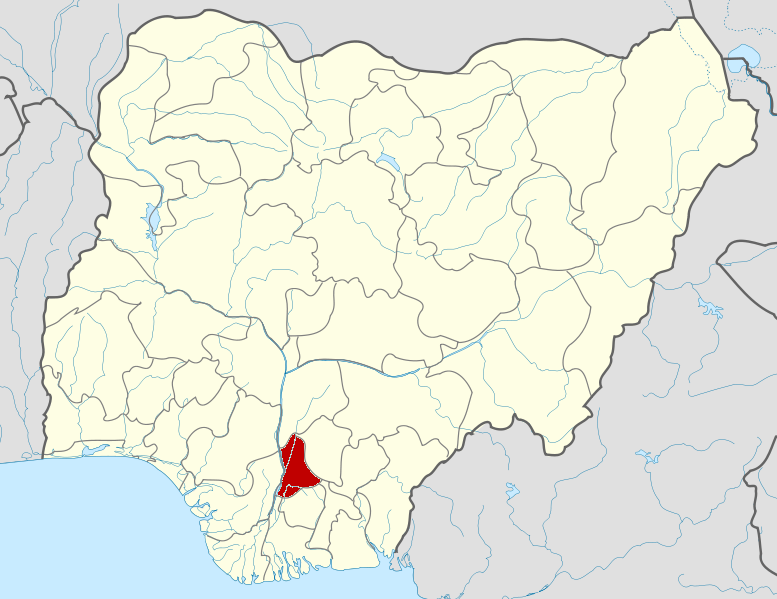
| Coordinates: Country Capital Governor Area Population (1991 census) - Total - Density GDP (PPP) - Year - Total - Per capita Time zone ISO 3166 code |
6°20′N 7°00′E Nigeria Awka Peter Obi (APGA) 4,844 km2 (1,870.3 sq mi) 4,055,048 837.1/km2 (2,168.2/sq mi) 2007 - Total $11.83 billion - Per capita $1,615 WAT (UTC+01) NG-AN |
Anambra is a state in south-eastern Nigeria. Its name is an anglicized version of the original 'Oma Mbala', the name of the river now known as Anambra which the state is named after. The Capital and the Seat of Government is Awka. Onitsha and Nnewi are the biggest commercial and industrial cities, respectively. The state's theme is "Light Of The Nation". Boundaries are formed by Delta State to the west, Imo State and Rivers State to the south, Enugu State to the east and Kogi State to the north. The origin of the name is derived from the Anambra River (Omambala) which is a tributary of the famous River Niger.
The indigenous ethnic group in Anambra state are the Igbo (98% of population) and a small population of Igala (2% of the population) who live in the North western part of the state
Anambra is the eight most populated states in the Federal Republic of Nigeria and the second most densely populated state in Nigeria after Lagos State. The stretch of more than 45 km between Oba and Amorka contains a cluster of numerous thickly populated villages and small towns giving the area an estimated density of 1,500–2,000 persons living within every square kilometer of the area.
Resources
Anambra is rich in natural gas, crude oil, bauxite, ceramic and has an almost 100 percent arable soil.
In the year 2006, foundation laying ceremony for the first Nigerian private refinery Orient Petroleum Refinery (OPR) was made at Nsugbe-Umuleri area [1]. The Orient Petroleum Resource Ltd, (OPRL) owners of OPR, was licensed in June 2002, by the Federal Government to construct a private refinery with a 55,000 b/d capacity.
Furthermore, Anambra state is a state that has many other resources in terms of agro-based activities like fishery and farming, as well as land cultivated for pasturing and animal husbandry.
Currently, Anambra State has the lowest poverty rate in Nigeria.
History
Anambra possesses a history that stretches back to the 9th century AD, as revealed by archaeological excavations at oraukw and Ezira; Great works of art in iron, bronze, copper, and pottery works belonging to the ancient Kingdom of Nri, revealed a sophisticated divine Kingship administrative system which held sway in the area of Anambra from c. 948 AD to 1911.
During the Nigerian/Biafran war, a relief airstrip, was constructed by Biafran Engineers in the town of Uli/Amorka(code named "Annabelle"). Extremely dangerous relief flights took off from Sao Tome and other sites loaded with tons of food and medicine for the distressed Biafran population. Uli/Amorka airstrip was the site were brave American pilots like Alex Nicoll, and scores of others, made the supreme sacrifice in the service of humanity, delivering tons of relief supplies to the Biafran population. Disgusted by the suffering and mounting death toll in Biafra from starvation as well as the continuous harassment of the relief planes by the Nigerian Airforce, Carl Gustaf von Rosen resigned as a Red Cross relief pilot and helped Biafra to form an Airforce of five Minicoin planes malmo MFI-9 stationed at the Uga airstrip.He named his tiny but effective airforce "Babies of Biafra" in honour of the babies who died via starvation inside Biafra.
Old Anambra State was created in 1976 from part of East Central State, and its capital was Enugu. A further re-organisation in 1991 divided Anambra into two states, Anambra and Enugu. The capital of Anambra is Awka.
Culture and Tourism
Agulu Crocodile Lake is located along Awka road in Agulu, Aniocha Local Government Area of the state. A potential tourist site, it is home to an estimated three hundred crocodiles and water turtles. Fishing is not allowed on the lake and the crocodiles, being sacred animals to the people, cannot be killed. Legend says that these crocodiles were instrumental in delivering the town from enemy soldiers during the Nigerian civil war. It is believed that these sacred crocodiles and turtles transformed themselves into beautiful ladies and lured the soldiers unawares into the lake where they disappeared without trace. At noon the crocodiles and the turtles appear at the banks of the lake to take in sunlight.
Ogbunike Caves, listed by UNESCO as a world Heritage Site is one of the most visited tourist sites in Anambra State. It is classified as a Sandstone cave (Lateritic sandstones of Campanian-Miocene age). It has very scenic vegetation with attractive waterfall. It is situated in the Ogba hills Ogbunike, across the Ugwu-Aga Escarpment Umunya by the Enugu/Onitsha Expressway and lies in the coordinates of N06 11 11 and E06 54 21.
Igbo Ukwu Museum
lgbo Ukwu is an ancient town known for astonishing metalcrafts and has remained an attraction to tourists because of its bronze artifacts. The bronzes which were first noticed in 1938 and later excavated by Thurstan Shaw (an English archaeologist) date back to about the 9th century, are of high value and historic relevance.
Uzu-Oka: Awka is historically known for the great metal foundry, Uzu Craftmanship. Imo-Awka is an annual festival celebrated by the natives.
Ofala Festival

Other Anambra tourism potentials and cultural festivals include:
Ijele Masquerade listed in UNESCO Archives as Intangible cultural element [5] Ijele dance festival is home to the 'Olus' of the Omambala area: Omor, Aguleri, Umuleri, Awkuzu, Umunya, etc.
Omaba Yearly New-Yam Festival.
Ozubulu New-yam festival
Ozoebunu masquerade of Ozubulu
Ajana-Ukwu and Igu aro festivals at Omor.
Obu Gad at Enugwu Aguleri.
Ini Iguedo (Iguedo Grave) at Nando.
Odinani Museum at Nri.
Ini Eri (Eri Grave) at Ivite, Aguleri
Afia olu Festival in Nnewi. Attracts thousands of visitors annually.
The River Niger at Onitsha and Asaba with the famous Niger bridge is the eastern gateway linking the South East with Niger Delta and Western Nigeria.
Uzoiyi Festival Umuoji attracts thousands of visitors annually.
Ofala (Ovala) Festival is the commemorat
ive of Kingship celebrated by various towns. It was popularised by Onitsha town.
Igu-Aro is the major ki•ngship festival among the Nri.
Nkpokiti Dance, Umunze is known for fantastic acrobatic performances.
Rogeny Tourist Village at Oba (a stadium that is equipped with recreational activities including a swimming pool, zoo, shrine, soccer stadium, et
Education
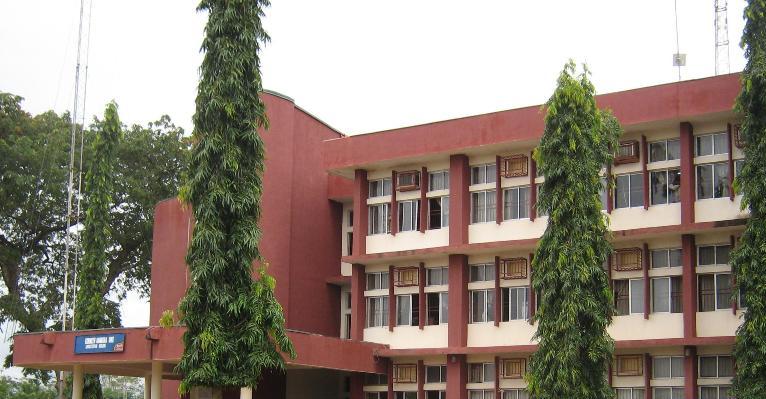
Nnamdi Azikiwe University
Awka, the state capital, is also the center of Nigeria's metalwork and carving industries. Educationally, Anambra is a centre of excellence. There are the Nnamdi Azikiwe University (UNIZIK), Awka a federal university with College of Medicine situated at Nnewi. The UNIZIK Nnewi runs a modern Teaching Hospital with facilities also at Umunya and Ukpo.
The Anambra State University, formerly known as Anambra State University of Science and Technology (ASUTECH), with two campuses, one in Uli, and another at Igbariam; the Federal Polytechnic, Oko; Nwafor Orizu University of Education (formerly known as the Nwafor Orizu College of Education), Nsugbe. Private Universities include The Tansian University, Umunya and Madonna University, Okija.
Literacy rate in the state is comparatively high. Some of the more notable secondary schools include Dennis Memorial Grammar School (D.M.G.S) Onitsha;Bishop Crowther Seminary Awka; St Christopher's Junior Seminary 3-3 Onitsha; Girls' Secondary School Onitsha; Zixton Secondary School Ozubulu; St Peter's Special Science School Achina; Girls' Secondary School Ozubulu; St Charles' Special Science School (SCSSS), Onitsha; Christ the King college (C.K.C) Onitsha; Our Lady's High School Onitsha; Comprehensive Secondary School Nawfia; Queen Of the Rosary College (Q.R.C.) Onitsha, St. Monica's College Ogbunike; Nnamdi Azikiwe Secondary School, Abagana; St Mary's High School Ifitedunu; Igwebuike Grammar School Awka; Lorretto Special Science School Adazi; Father Joseph Memorial High School Aguleri; Girls High School Umunya; Ajalli Government School; Community Secondary School Igbariam and many more. Primary and secondary school enrollment in the state is one of the highest in the country.[citation needed] Consequently, Anambra state has the highest number of JAMB candidates going after the limited number of spaces in Nigeria's tertiary colleges.
Politics
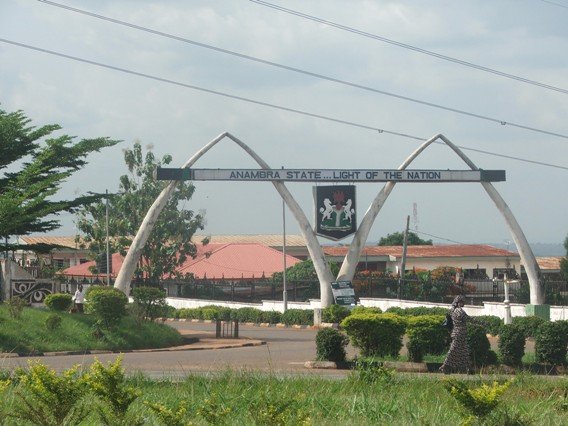
Anambra State Government House
Anambra's political history can be described as awesome, weird and unique depending on the aspect one turns to. It is a state with a long list of "firsts" in Nigeria history that dubbed the sobriquet "The Light of The Nation". On May 29, 1999, Dr. Chinwoke Mbadinuju was sworn in as civilian governor of Anambra state, after many years of military rule. His administration was marred by heavy problems. The most notable is the teachers' salary which was withheld for a long time. This led to a ten-months strike in all the government secondary schools in the state. Also, before his rule, secondary education had been free of charge. But his administration prescribed a tuition fee of 3000 Naira per term for all secondary schools, which led to an unprecedented massive demonstration by the secondary school students from all over the state. Many people attribute Mbadinuju's failure to political godfathers a debacle that also trailed his successor. On May 26, 2003, Dr. Chris Ngige was sworn in as the new governor of the state, but he was removed in March 2006 when Mr. Peter Obi of APGA dragged him to court on charges of electoral malpractice. The Court of Appeal in Enugu asserted that his election victory in 2003 was fraudulent and ordered him to leave the seat.[5] Peter Obi was in turn ousted by a faction of the Anambra State House of Assembly on November 2, 2006 and replaced by Virginia Etiaba, his deputy. On February 9, 2007 Mrs. Etiaba handed power back to Obi after the Court of Appeal had nullified Obi's removal.
On April 14, 2007, Mr. Andy Uba of PDP was "elected" the new governor of the state and, on May 29, was sworn in as the new governor. The election was reported to be massively rigged and was disapproved all over the country. On June 14, 2007 the Supreme Court of Nigeria removed Mr. Andy Uba from office and replaced him with his predecessor Peter Obi, on the ground that Peter Obi's tenure had not ended, therefore there was no vacancy in the governorship. [6] On Saturday, 6 February 2010, Peter Obi was re-elected governor for a second term of four years, after a hot contest with Dr. Chris Ngige, a former governor of the state; Prof. Charles Soludo, a former governor of the Central Bank of Nigeria and Mr. Andy Uba who was a strong voice in the state's politics. Other contenders included Mrs Uche Ekwunife, Prince Nicholas Ukachukwu and many others. Altogether, there were twenty-five contestants for the office. Mr. Peter Obi was named the winner of the election, with more than 30% votes above the immediate runner-up.
Cities and administrative divisions

Niger Bridge - Gateway into Anambra
With an annual population growth rate of 2.21 percent per annum, Anambra State has over 60% of its people living in urban areas making it one of the most urbanized places in Nigeria.
The major urban centres of Anambra state are Onitsha including Okpoko, Nnewi, and Awka. Awka and Onitsha developed as pre-colonial urban centres with Awka as the craft industrial centre of the Nri hegemony; and Onitsha the city state on the Niger and a river port and commercial centre.
Onitsha is a fast-growing commercial city, and has developed to become a huge conurbation extending to Idemili, Oyi and Anambra East LGAs with one of the largest markets in West Africa. Nnewi (the Taiwan of Nigeria) is a rapidly developing industrial and commercial centre; and Awka, by becoming the state capital is, as it were, regaining its precolonial administrative eminence.
Other main towns of Anambra state are: Awgbu, Igbariam, Omor, Nkwelle-Ezunaka, Abatete, Awka-Etiti, Achina, Agulu, Amorka, Aguluezechukwu, Ogidi, Obosi, Ihiala, Amichi, Uga, Uli, Ubuluisiuzor, Abagana, Alor, Nsugbe, Atani, Nkpor, Eziowelle, Ezinifite, Oba, Ichi, Ojoto, Oraifite, Ozubulu, Umuawulu, Umunze, Umuoji, Umunachi, Umudioka, Unubi, Umunya, Umuleri, Utuh, Ogbunike, Aguleri, Ekwulobia, Igbo-ukwu, Ichida, Ora-Eri, Ihembosi, Akwaukwu, Uke, Ukpo, Ifitedunu, Okija, Ajalli, Oko, Oraukwu, Osumenyi, Nnobi, Nnokwa, Ideani, Adazi-Nnukwu, Adazi-Enu, Umuanaga, Adazi Ani, Nanka, Nimo, Nneni, Nmiata-Anam, Awkuzu, Ebenebe, Enugwu-Ukwu, Enugwu-Agidi, Umueze-Anam, Nawfia, Amawbia, Agukwu, Nando, Nanka, Nnokwa, Amansea, Amanuke, Achalla, Mgbakwu, Ugbenu, Ugbenne, Umuchu, Umuomaku, Isuaniocha, Azia, Utuh, Akwaeze, Omogho, Akpu, Amesi, Ebenator, Nibo, Mbaukwu, Nise, Achala, Ukpor, Akpo, Okpeze, Amaetiti, Iseke, Isuofia, Oba-Ofemili, Okpeze, Nawfija, Isulo, Ufuma, Aguluzoigbo, Ogbunka, Osumoghu, Ezinihite, Ezira, Obeledu, Ndiukwuenu, Nawgu, Awa, Nkpologwu, Amaokpala, Owellezukala, Ndi-okpaleke, Ndikelionwu, Abba,
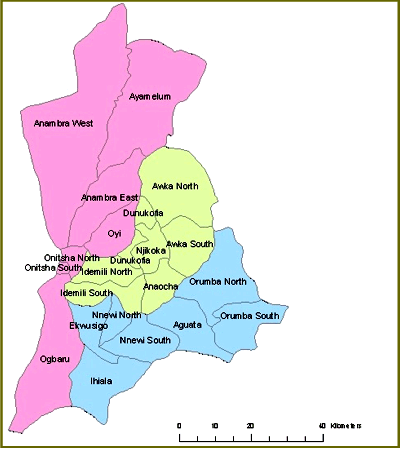
Anambra State LGA Map
There are 21 local government areas in the state:
Aguata
Awka North
Awka South
Anambra East
Anambra West
Anaocha
Ayamelum
Dunukofia
Ekwusigo
Idemili North
Idemili South
Ihiala
Njikoka
Nnewi North
Nnewi South
Ogbaru
Onitsha North
Onitsha South
Orumba North
Orumba South
Oyi
Urbanization and Structural Planning
Over the last two decades the rural/urban exodus has caused a shift making Anambra a highly urbanized state with 62% of its population living in urban areas.
Faced with decades of neglect and bad governance, the shift in human migration has posed problems to available infrastructural provision, environmental sanitation, erosion control and other social services. As a result, major cities have become characterized by inadequate and deteriorated road networks, walkways, unregulated building patterns, sanitation, uncontrolled street uncontrolled street trading, mountains of garbage, and chaotic transport systems, creating congestion, noise pollution and overcrowding.
To address this situation, the government of Peter Obi with the assistance of the UN-HABITAT produced 20-year structural plans (2009–2028) for three major cities in the State, Onitsha, Nnewi and Awka Capital Territory to restore urban planning and guide their growth into the future.
The plans contain policies and proposals for land use, city beautification, road infrastructure, industrial development, housing, waste disposal, water supply and health and educational facilities to turn the cities into Anambra into successful urban areas to generate employment, wealth and provide high living standards for its residents.[8]
Anambra became the first state in Nigeria to adopt Structural Plans for its cities and with effective implementation should systematically grow as a major economic center in Nigeria and West Africa.
The process of urbanization is fairly contributed by population growth, immigration, migration, and infrastructure initiatives like good road, water, power, and gardens, resulting in the growth of villages into towns, town into cities and cities into metros. However, in such a phenomenon for ecological feasible development, planning requires an understanding of the growth dynamics, if not people will continue moving from our villages in search of greener pasture living only the aged men and women to farm, this is noticeable in Amesi, Akpo, and Achina towns in Aguata local government area. They major in the production of yam,Cocoyam and cassava through consistent agriculture. These agricultural activities have in recent time suffered a setback due to massive out-migration of their youths to the urban centres, thereby resulting in food scarcity and over population in urban environment.
Notable people
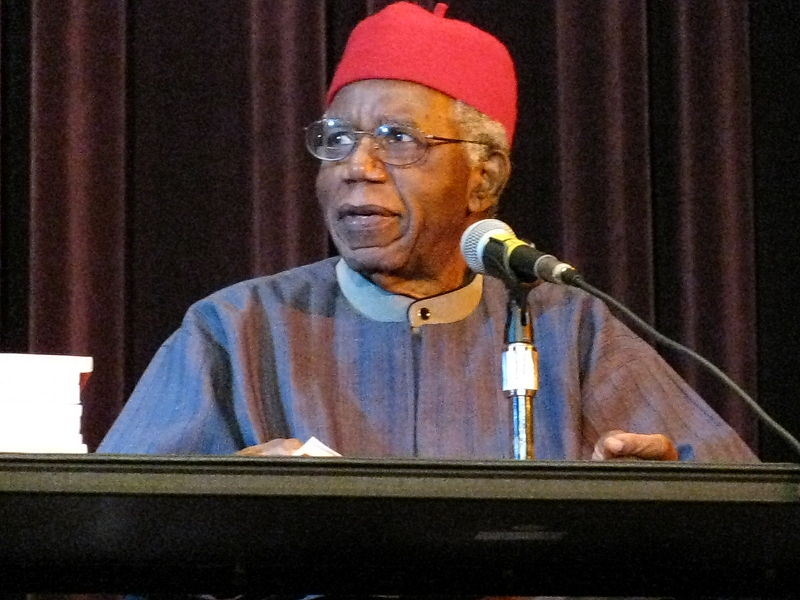
Chinua Achebe
Despite its relatively small landmass, Anambra has produced a fair number of outstanding individuals and a number of firsts in Nigeria. Anambra natives include:
Nnamdi Azikiwe Owelle of Onitsha - the first President of the Federal Republic of Nigeria and historically, the only man whose name appeared in the Constitution of his country (Nigeria's Republican Constitution of 1963).
Dr. Alex Ifeanyichukwu Ekwueme, hails from Okoh town, is a frontline Politician, Architect and the first executive Vice-President of Nigeria, serving 1979 – 1983.
Professor Chinua Achebe - a native of Ogidi and best known for the classic, Things Fall Apart was the first African writer whose books are standard curricula in schools and universities across the world.
Emeka Anyaoku - the first black Secretary-General of the Commonwealth;
Nwafor Orizu - the first Senate President of the Federal Republic of Nigeria.
Lieutenant-General Chikadibia Isaac Obiakor, appointed in 2008 by UN Secretary-General Ban Ki-Moon as Military Advisor on UN Peacekeeping Operations. Previously served as Commander of the Economic Community of West African States Monitoring Group (ECOMOG) Artillery Brigade in Liberia in 1996 and 1997, and as ECOMOG Chief Coordinator of the Liberian elections in July 1997.[9]
Professor Humphrey Nwobu Nwosu. A Professor of Political Science. Former NEC Chairman. Conducted the freest, fairest and most credible election so far in Nigeria.
Chinyelu Onwurah, a British Labour Party politician, who was elected at the 2010 general election as the Member of Parliament for Newcastle-upon-Tyne Central, becoming the first female British MP of African origin.
Chuka Umunna, a British Labour Party Member of Parliament for Streatham constituency.
Professor Kenneth Dike - a pre-eminent scholar of African History and native of Awka, was the first indigenous Vice-Chancellor of the University of Ibadan and founder of the National Archives.
Professor Ben Enwonwu - a native of Onitsha was the first Nigerian sculptor of international repute with artwork gracing the United Nations headquarters.[10]
Pius Okigbo, CON[7] - a world renowned economist, was the first economic advisor to the Federal government of Nigeria (1960–1962), first Nigerian Ambassador to the European Community and renowned for bringing to light over $12 billion missing in oil windfall receipts from the Central Bank of Nigeria during the first Gulf War.
Professor Samuel Okoye - was black Africa's first PhD in Radio Astronomy who along with Antony Hewish of the University of Cambridge discovered the radio source of Crab Nebula neutron star.
Ebuka Obi-Uchendu - Writer, television presenter, lawyer and Big Brother reality star. Noted for continuously pushing for a positive outlook on the 'Okija Shrine'.
Chief Jerome Udoji - from Ozubulu [8], a social reformer was the first African to be made a 'D.O' (District Officer) by the Colonial Administration.
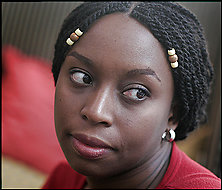
Chimamanda Adichie
Others include:
Amobi Okoye - Youngest American football player to play for the NFL (2004), currently plays for the Houston Texans
Chimamanda Adichie - writer who won the Orange Prize for Fiction (2007) and a MacArthur Foundation Fellowship (2008);
Dora Akunyili - ex-head of NAFDAC and current Minister of Information won international awards for cleansing Nigeria of the scourge of fake drugs;
Cardinal Francis Arinze, once considered a potential Pope
Cyprian Ekwensi - MFR, a writer of international repute
Philip Emeagwali - winner of the 1989 Gordon Bell Prize for Supercomputing;
Prof Chike Obi - a Mathematician famous for his work on non-differential equations won the 1985 ICTP Price and developed a special solution for Fermat's Last Theorem ;
Louis Odumegwu Ojukwu - a native of Nnewi who was the first Nigerian millionaire and first president of the Nigerian Stock Exchange;
Dim Emeka Ojukwu - the leader of the secessionist Biafra Republic;
Osita Osadebe - a popular Nigerian Highlife musician who also holds the Nigerian record for the highest selling album
Professor Charles Chukwuma Soludo - a famous economist who spearheaded Nigerian economic reform from 1999–2008 and was ex-head of the Central Bank of Nigeria;
Becky Umeh - dancer, choreographer, and musical director who performed throughout Nigeria 1994 - 2002, and Washington DC, 2002–present.
[[Ezenwenyi Stanley Chidiebere], a great computer engineer,database administrator,and a famous politician. he hails from Umueze in Ezinifite town.
Chinwe Chukwuogo-Roy MBE, a London-based visual artist. The first black artist to paint a portrait of Queen Elizabeth II when commissioned to paint the official Golden Jubilee portrait. She was chosen as one of the UK Women of the Year in 2002 and 2003, represented the UK at the Council of Europe and was awarded an Honorary Doctorate of Letters by the University of East Anglia. During 2006 her work was represented on the national postage stamps of six countries. In 2008 she addressed the Cambridge Union Chukwuogo-Roy is a regular contributor to the BBC and other current affairs programmes. In 2009 she was made an MBE in the Queen's Birthday Honours List.